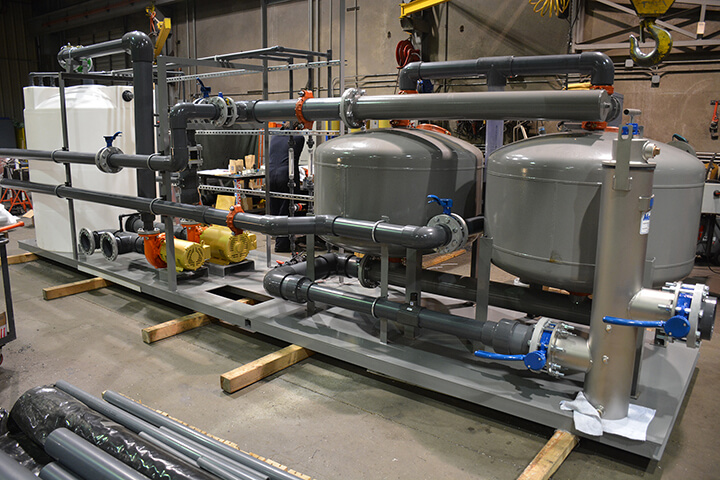

This large, powerful mixing packaged system was designed and manufactured entirely at Mitchell’s Wilsonville facility for our client: WaterTec. Ultimately, the finished, component, four pad system will be used in blending and dispersing combinations of water, fertilizers and other liquids in achieving and sustaining the ideal mixes to support commercial vegetation farming. This style system is not only for tomatoes, but is also used for large scale growing of cut flowers, specialty cucumbers, red/orange/yellow sweet peppers, annual bedding plants, poinsettias and herbs.
This unit will serve to mix fertilizers into and lower the PH of water that is on its way to the plants. When the irrigation water comes from the well, it is treated and filtered to remove all particulates and organic materials that could affect the plants. Depending on the water quality, there may be no treatment beyond microfiltration, but typically treatment would include RO, ozone gas, pasteurization, or chlorine gas. This water is typically blended with left over water from previous watering cycles that has not been taken up by the plants. That water is filtered and sometimes treated before being blended back with the treated water. This return water is reused as much as is practical to reduce the energy cost of water treatment, to utilize trace fertilizers entrained in the water, and to mitigate high nitrate waste water discharge.\
One pump on this skid is called the fill pump. When an irrigation cycle is initiated, water is pulled into this pump through two pipes, one being the return water and the other the treated water. The water is blended by using a modulating valve system to accurately maintain their correct proportion. The fill pump pushes this water into a mixing tank where up to 5 different fertilizers and acid is introduced in direct proportion to the volume of water being pumped to the plants, as measured by a flow meter downstream of a second pump, called the booster pump. This pump moves all the blended and fertilized water from the mixing tank through additional media filters and on to the plants, as well as drive water through EC and PH sensors to confirm correct adherence to the growers fertilizer and PH requirements.
It used to be that growers grew their plants in small isolated blocks within the greenhouse, so that they were assured of a constant, rotating crop in production. Now the common method is to plant a block to 50% capacity and when that crop is at 50% maturity, plant new plants between the existing ones to maintain a continuous crop. This requires two independent parallel irrigation systems as the growing and maturing plants have different irrigation and fertilizer requirements.
Michael Watterson
Packaged System Product Manager, MLS
